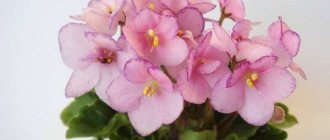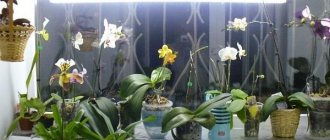In 1737, the botanist Jan Gronovius first described the Transvaal daisy and named it in honor of his friend, the naturalist Traugott Gerber. Under the name "gerbera" the plant fell into Linnaeus' classification of the natural world. But they began to cultivate it much later - in 1884, when researcher Robert Jameson discovered the flower on the shores of South Africa. Gerbera Jameson is one of the first varieties, the progenitor of those that we are used to seeing as cut flowers. In this article we will tell you what does this flower symbolize
and when it is appropriate to give it.
Botanical description and history
Yellow gerbera belongs to herbaceous perennial plants of the Asteraceae (Asteraceae) family .
It has a thick stem and feathery leaves collected in a rosette, pointed at the end, up to 20 cm in length. Inflorescences are baskets with a diameter of 5-15 cm, bright in color. Has tubular central flowers. They bloom for about 3 – 5 months, in nature this happens twice a year. The petals are velvety. The fruit of a gerbera is an achene. The root system is developed and quite powerful. Peduncles are tall, up to 60 cm.
In nature, it grows in the subtropics, its homeland is South Africa. The flower was discovered there at the beginning of the 18th century by the botanist Gerber, hence its name. But there is also a long-standing beautiful legend about the origin of gerbera. In ancient times, there lived a forest nymph, Coat of Arms, of incredible beauty; everyone envied her and gave her no rest. And she really wanted to become invisible and in the end turned into a simple flower.
Appearance and features
The yellow gerbera in its appearance resembles a solar disk, and its petals resemble the rays of the sun . But there are varieties in which the petals are yellow, and the central part of the flower is much darker, and even approaches black.
Yellow gerberas can be double (similar to an aster), single (similar to a chamomile) or semi-double (something between an aster and a chamomile). It is not for nothing that the second name of gerbera is Transvaal chamomile. The petals are found both round and pointed.
Flowers in diameter can be small or large. Yellow gerbera lives 3 – 4 years. Basically, all the varieties of yellow gerberas we encounter are hybrids bred by breeders (Helios, Vega, and others).
All indoor and garden gerberas come from Jameson's gerbera and green-leaved gerbera . But only dwarf varieties with a height of no more than 30 cm are suitable for home cultivation. The varieties Orangina, Sweet Caroline and Sweet Honey are most often grown from yellow gerberas. Yellow gerbera lasts a long time when cut.
What are gerberas given for?
A bouquet collected from sunny gerberas is given exclusively with good intentions. This is an appropriate gift if you need to confess your love, make a compliment about your appearance and wish you health. Gerberas can be presented to a person for whom you feel respect, appreciation, gratitude and admiration.
Gerberas will appeal to young active people who are used to moving forward and achieving their goals. This is the perfect flower for a first date - not too fussy, inexpensive, but cute and beautiful. To correctly express feelings without words, you need to choose gerberas taking into account the following recommendations:
- a multi-colored bouquet of yellow and red gerberas will help you wish happiness, prosperity, cheerfulness and smiles;
- you can confess your love with the help of an author's floral composition of red and pink gerberas;
- friendly care, respect and support are best expressed by bouquets of plain gerberas.
If you are given gerberas as a gift, take it as a good sign. These flowers are given for good luck. They attract wealth into the home, so be sure to place the bouquet in the most visible place.
Photo
Below you will see a photo of a yellow gerbera:
Where and how to plant it?
Gerbera belongs to the group of plants that do not tolerate even small deviations from optimal care. Therefore, if a gardener, and especially a beginner, cannot devote much time to this activity, experienced gardeners do not recommend purchasing it.
Almost all yellow gerberas sold in pots in the store are brought from Holland . Therefore, having bought such a flower and brought it home, you do not need to touch and replant it immediately. Let him rest and adapt for two weeks. Then you need to carefully replant.
- Carefully remove the store soil and wash it off.
- You can plant gerberas in ready-made universal soil; be sure to use drainage.
Do not add humus or rotted compost to avoid burning the roots. In December - January the plant is not fed.
It is better to place the transplanted gerbera on a windowsill in a room facing west or east, with moderate heating . Normal room humidity and frequent ventilation suit it. But in winter it is recommended to insulate the pallet so as not to overcool the roots.
Important! Under no circumstances should a gerbera be replanted during the flowering period. At this time she is very weakened.
If the gerbera is poorly adapted, you can create a small greenhouse by placing it in a bag and periodically ventilating it.
The second time, the grown yellow gerbera is replanted, increasing the diameter of the pot by 2 - 3 cm, but still quite tight. This is necessary for abundant flowering.
In summer, yellow gerbera can be planted outside in open ground . But it is important not to forget that optimal growing conditions should be close to native ones. She does not like sudden changes in day and night temperatures. In winter - no lower than 12 C. So you can grow yellow gerberas only in the south of Russia. In other regions, it is better to do this in greenhouses or in an apartment.
Gerberas love bright, diffused light; they are moderately moisture-loving, but quite capricious.
Read more about when and how to replant gerberas after purchase here.
Lighting and location
Gerberas are light-loving plants, but do not tolerate direct sunlight well . Therefore, if a flower pot is placed on a window or balcony, in extreme heat it is better to make a small shade. Normal daylight hours are 10–12 hours.
Often there is not enough natural light, then you need to add additional light, preferably a phytolamp, it has a very good effect on the microclimate. The lamp is located above the pot about 80 cm at a slight angle.
With the right lighting, yellow gerberas bloom profusely (read about why indoor gerberas may not bloom in this article). Flowering period: September – December.
Soil requirements
Gerberas, like all plants, obtain the necessary substances from the soil. Therefore, you need to approach the choice of soil responsibly.
For yellow gerberas, a slightly acidic soil composition (pH – 5 – 6) is suitable. Acidity must be indicated on the label of the finished primer. You can buy universal earthen mixtures or specialized ones (with the addition of crushed charcoal and vermiculite).
Almost all ready-made soil mixtures are additionally enriched with nutrients . They also use a mixture of leaf soil, sand and peat (2:1:1) or pure perlite, but then constant feeding is necessary. Organic fertilizers for gerberas are prohibited.
Regardless of the soil chosen, be sure to add drainage to the bottom of the pot (about 1/4 of the pot). It is better to fertilize with mineral fertilizers once every two weeks in spring and summer, once a month in autumn, and not to fertilize at all in winter.
Gerberas: growing in open ground in the garden, at the dacha
Growing gerberas in open ground is not an easy task. These are annual plants, so they will have to be sown every year. And seed germination will depend on weather conditions. As you know, gerbera needs light and warmth.
When cold weather sets in, you can dig up the roots of the gerberas and try to save them until next year. This is what they do with dahlias, for example. However, gerbera roots need to be stored in a dry place with a ball of earth; they need to be covered with straw and a layer of dry leaves. The temperature at the storage location should be about 8º.
Important: In Africa, gerberas grow on their own, but the climate of Russia and many other countries does not allow gerberas to grow without problems.
Growing in open ground
How to properly care?
Caring for a gerbera consists of creating comfortable growing conditions for it . And the main difficulty in growing is gerbera’s love for stability.
You need to water frequently, but moderately. The plant suffers even more from excess water than from its lack. Tap water is taken and left standing for at least 24 hours. You cannot water with boiled water, there is no dissolved air in it. For watering, it is better to use a watering can with a long spout.
Attention! When watering, water should not fall on the petals, leaves, and especially on the rosette of basal leaves, otherwise the roots of the gerbera will rot.
After watering, if the soil becomes crusty, it needs to be loosened. It is better to water in the evening. The soil should always be moderately moist. It is also better to humidify the air by spraying it with a spray bottle or a humidifier. Normal humidity is 70 - 80%.
Periodically, gerberas need to be fed with mineral fertilizers , but here it is also important not to overdo it and remember the golden rule of feeding about the indispensability of elements. So, when buds form, gerberas need potassium. If there are pale spots on the leaves, iron is needed.
After transplanting the gerbera, the first fertilizing is carried out no earlier than three weeks later, with mineral nitrogen-containing fertilizers. When replanting, it is important to disinfect the pot and use a sterilized substrate.
You can find out how to care for gerbera in a pot here.
Watch the video on how to properly care for the plant:
Choice for bouquets
Florists love gerberas; they take into account the meaning of the flower when creating bouquets, focusing on the general meaning - joy, smiles, happiness. They collect both mono-bouquets, consisting only of plants of the species we are considering, often even different varieties, and prefabricated compositions. In the case of the latter option, florist masters have to apply all their knowledge about floristic art. They combine gerberas with beautiful roses, delicate tulips, bright sunflowers, and other flowers. For volume, florists choose different greenery, and for decoration - craft paper, mesh, felt and other packaging materials that give the finished composition a special zest.
Common diseases and pests
Fungal diseases (powdery mildew, root rot). They occur mainly due to excessive watering. The gerbera fades and the stems turn black. A white or grayish coating may appear on the leaves, they turn yellow and curl (you can find out why gerbera leaves turn yellow and how to treat it here). Systemic fungicides are used. If the soil mixture emits an unpleasant odor, you should immediately replant the yellow gerbera.- Damage by aphids . The leaves turn yellow and small black spots are visible on the underside. If spotted early, pests can be eradicated manually. At a later stage, chemicals are used against aphids.
- Spider mite . The gerbera seems to dry out, as small cobwebs draw all the juice out of it. In this case, you need to humidify the air around the gerbera and use insecticides (Anti-mite). A decoction of tomato tops, infusions of wormwood, and Persian chamomile are also recommended.
- Whitefly infestation . These are small caterpillars that eat holes in leaves. Spray with preparations containing peremethrin.
- Shield . This is a pest and can be seen on the underside of leaves as brownish scales. At an early stage it is destroyed manually, at a later stage - with chemicals.
- Mosaic . The gerbera weakens, sharply defined light spots appear. At an early stage, spray with Bordeaux mixture. An advanced disease cannot be treated.
You can read more about gerbera diseases here.
Watch the video showing an example of a disease on a plant:
Meaning
What do gerberas mean?
- Good luck if you collect yellow and orange ones in a bouquet;
- Joy, a smile - with a combination of bright inflorescences;
- Love, devotion to the woman you love – deep red;
- Wishes of happiness and warmth - red shades diluted with yellow;
- Respect for a man if dark burgundy is chosen;
- Good mood - bouquets of flowers of contrasting colors.
Gerbera also represents mystery. It can be given as a gift if you want to flirt with a woman, but in this case you should choose buds with gentle transitions, for example, from white to pink or from pink to red, scarlet.
Reproduction
Gerberas are propagated by:
- Seeds . It is of great importance for breeders, as it allows you to grow gerbera with the desired characteristics. Seeds germinate in about one month. They are planted in moist, loose soil, sprinkled with earth. Then cover with film. Open periodically and spray with water. When small sprouts with leaves appear, transplant them into pots. It takes about ten months before flowering. Not all amateur flower growers have enough time for this, so more often gerberas are propagated vegetatively.
- By cuttings . For cuttings, you need to provide heating, high humidity, and use phytohormones. A small cutting with a small stem (a couple of centimeters) and leaves is cut from an adult gerbera. After planting, cover with film, ventilate, and moisten. Remove the film at the beginning of active growth.
- Dividing the bush . Free the gerbera from the ground, divide the root system into several separate ones and plant it in the ground.
More nuances about gerbera propagation can be found here.
Yellow gerbera is considered a rather capricious plant, requiring the creation and maintenance of a certain microclimate. But if you wish, it is not difficult to adhere to the rules and provide comfortable conditions for the growth of such an amazingly beautiful flower, replant it in time, and treat it. In return, gerberas will please the eye and give joy.











